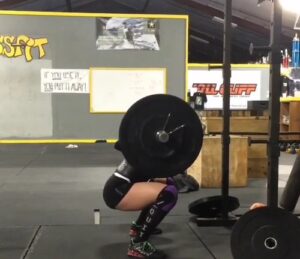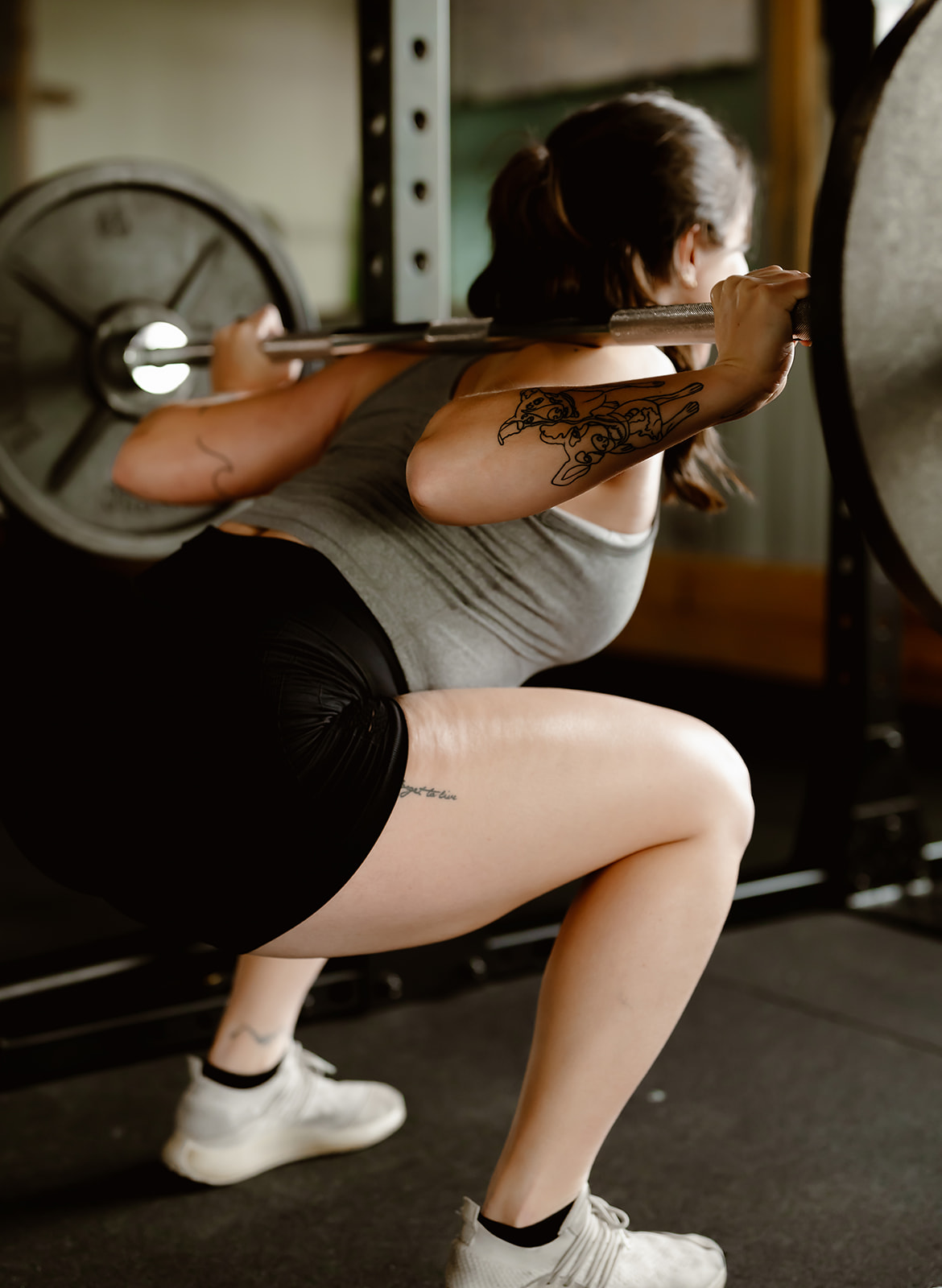THE WHY: FULL ROM SQUATS
Quarter squatting? It’s probably time to rethink the way you train. In this article we will discuss why quarter and above parallel squatting does not provide the full hypertrophy and strength benefits as the below parallel squat does. A full range of motion squat causes greater stress on the posterior chain, which develops more overall strength and a better base of power for the rest of your lifts. Your posterior chain contains some of the strongest muscles in your body so you really are short-changing yourself if you are performing quarter squats in the gym.
Muscle Size and Strength
We’ve all been told to squat deeper for a bigger butt and stronger glutes. A study from 2002 showed greater muscle activity with increasing squat depth. This was utilizing the same absolute load for the squats. So, 135 on your back will do much more for you as far as muscle activation at a deeper squat. Interestingly, a recent study has shown that muscle activity was quite similar at a parallel and a deep squat with the same RELATIVE loads. We know that a full range of motion is harder work, so utilizing a lighter weight at less range of motion showed very similar muscle activation. Still, the deep squat wins because of the following points.
The full squat puts the body under greater physiological stress. By achieving a full stretch in the full range of motion during the squat, you are increasing time under tension and working harder longer to handle the load. Multiple studies (like the following from 2012, 2013, and 2014) have shown that full range of motion training will lead to greater strength and size. Full range of motion training not only leads to greater hypertrophy, but also helps with keeping those gains when you take a break from training. Training the muscle at longer length has been shown to lead to retention of improvements when subjects stopped lifting (McMahon, et. al, 2013).
Is breaking parallel on squats bad for your knees?
Many people think squatting below parallel is bad for the knees. That is utterly and completely false. Squatting below parallel is actually beneficial for knee joint health. The deeper in the squat you go, you will see more of an increase in knee stability. Allowing the knee to move in a full range of motion aids in tissue building around the knee joint and lessens the shear stress forced upon the knee when only squatting to parallel (Hartmann, Wirth, & Klusemann, 2013).

Performing deep squats at the start of your workout could also aid in more powerful movements during the remainder of the workout. The deeper the squat perfomed, the greater the power output. This effect, known as post-activation potentiation, helps “prime” muscles for greater contractile force for subsequent exercises. If you’re planning on doing some power movements, try doing a few sets of heavier full squats first. Check out this study to learn more.
In short, full range of motion always wins in terms of hypertrophy (muscle size), overall efficiency during a workout (stressing the body and getting the most bang for your buck), AND maintenance and retention of strength and size (if you don’t use it, you’ll be slower to lose it). Being strong at all joint angles is important for overall better function and working at the maximum range of motion you can achieve with solid form is important. So, if you aren’t hitting depth, lighten the weight and practice increasing your range of motion.
Powerlifting Rules
As for powerlifting, breaking parallel is a rule in pretty much every federation. Some federations are more lenient than others when it comes to depth on the squat, but the rules are similar in every rulebook. Here’s an image from the USAPL rulebook on what hitting depth should look like:

Image from USAPL Rulebook.
IPF Rulebook: “the lifter must bend the knees and lower the body until the top surface of the legs at the hip joint is lower than the top of the knees”
If you’re planning to compete, start working on hitting depth. Strength training is joint-angle specific. Training a partial squat will lead to an increase in strength for a partial squat. Parallel squat training will lead to strength increases at parallel. Breaking parallel in your training will increase your 1RM below parallel, which is the goal in any meet.
New Research!
If you’re a sprinter, a new study has just been released on partial squats and sprinting due to similar joint angles with performance. This study furthers the point that training is very joint-angle specific.
Why Can’t I Hit Depth?
The squat has so many variables that can be manipulated in order to achieve depth. Each person will have individual weaknesses and strengths that will need to be balanced in order to hit the depth they need. Bar placement, stance width, grip, muscle weakness, and mobility could be reasons that you can’t break parallel.
Trouble Hitting Depth? Check Out Breaking Parallel Part 2 where we will discuss tips and progressions for getting lower in the squat.
Happy Training!
Heather & Katie
The Power Couple
Ready to kickstart your fitness journey? Begin by tuning in to our podcast, ‘Stronger than your Boyfriend,’ for expert advice and tips. Then, elevate your experience by checking out our range of programs! Whether you’re seeking workout insights or personalized support, we’ve got you covered. Transform your body and mindset today. Press play on the podcast and delve into our programs to achieve your fitness goals together!
References:
Bloomquist, K., Langberg, H., Karlsen, S., Madsgaard, S., Boesen, M., & Raastad, T. (2013). Effect of range of motion in heavy load squatting on muscle and tendon adaptations. European Journal of Applied Physiology, 113(8), 2133-2142.
Caterisano, A., Moss, R. F., Pellinger, T. K., Woodruff, K., Lewis, V. C., Booth, W., & Khadra, T. (2002). The effect of back squat depth on the EMG activity of 4 superficial hip and thigh muscles. Journal of strength and conditioning research/National Strength & Conditioning Association, 16(3), 428-43
Contreras, B., Vigotsky, A. D., Schoenfeld, B. J., Beardsley, C., & Cronin, J. (2015b). A Comparison of Gluteus Maximus, Biceps Femoris, and Vastus Lateralis EMG Amplitude in the Parallel, Full, and Front Squat Variations in Resistance Trained Females. Journal of Applied Biomechanics.
Hartmann, H., Wirth, K., & Klusemann, M. (2014). Analysis of the load on the knee joint and vertebral column with changes in squatting depth and weight load. The Journal of Sports Medicin
Lorenz, D. (2011, September). Postactivation Potentiation: an Introduction. International Journey of Sports Physical Therap
McMahon, G. E., Onambélé-Pearson, G. L., Morse, C. I., Burden, A. M., & Winwood, K. (2013). How Deep Should You Squat to Maximise a Holistic Training Response? Electromyographic, Energetic, Cardiovascular, Hypertrophic and Mechanical Evidence. Electrodiagnosis in New Frontiers of Clinical Research.
McMahon, G. E., Morse, C. I., Burden, A., Winwood, K., & Onambélé, G. L. (2014). Impact of range of motion during ecologically valid resistance training protocols on muscle size, subcutaneous fat, and strength. The Journal of Strength & Conditioning Research, 28(1), 245-255.
Pinto, R. S., Gomes, N., Radaelli, R., Botton, C. E., Brown, L. E., & Bottaro, M. (2012). Effect of range of motion on muscle strength and thickness. The Journal of Strength & Conditioning Research, 26(8), 2140-2145.
Rhea, Kenn, Peterson, Massey, Simão, Marin & Krein, in Human Movement (2016). Joint-Angle Specific Strength Adaptations Influence Improvements in Power in Highly Trained Athlete




